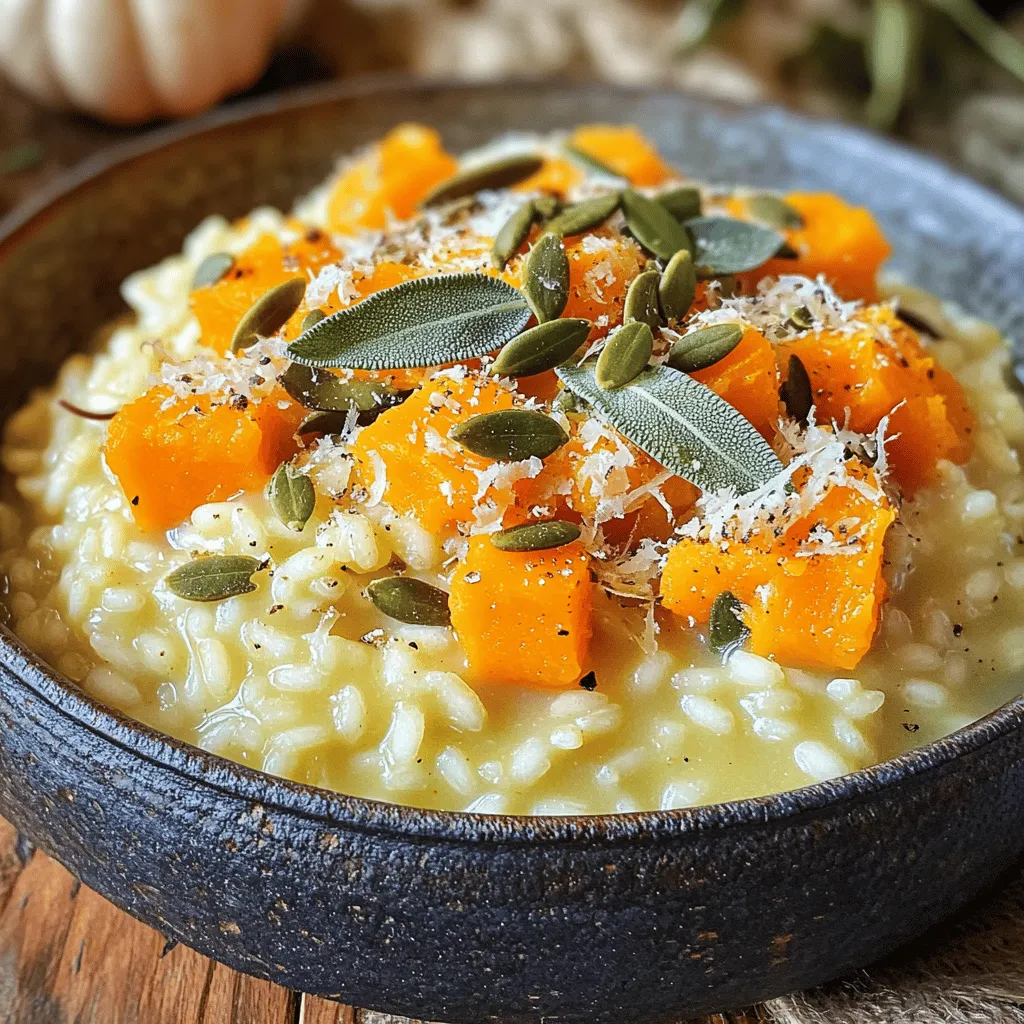Ready for a warm bowl of comfort? Butternut Squash Sage Risotto is a creamy delight. I’ll show you how to make this dish perfectly from the first step to the last bite. With fresh ingredients and simple tips, you’ll impress everyone at your table. Whether you’re a beginner or a seasoned cook, this recipe will soon be your go-to for cozy meals. Let’s dive into the warmth of this tasty treat!
Ingredients
Complete list of ingredients
To make a delicious butternut squash sage risotto, you will need:
– 1 cup Arborio rice
– 2 cups butternut squash, diced
– 4 cups vegetable broth
– 1 small onion, finely chopped
– 2 cloves garlic, minced
– 1/2 cup grated Parmesan cheese (or nutritional yeast for a vegan option)
– 2 tablespoons olive oil
– 1 tablespoon fresh sage, chopped (or 1 teaspoon dried sage)
– Salt and pepper to taste
– 1 tablespoon butter (or plant-based butter for a vegan option)
– Optional: pumpkin seeds for garnish
Tips for selecting fresh butternut squash
When choosing butternut squash, look for ones that are firm and heavy for their size. The skin should be smooth and free of blemishes. A rich, orange color indicates ripeness. If it feels soft or has dark spots, it might not taste great.
Substitutions for dietary preferences
If you want a vegan version, replace the Parmesan cheese with nutritional yeast. For a dairy-free option, use plant-based butter. To make the dish gluten-free, ensure your broth is labeled gluten-free. This way, everyone can enjoy this creamy risotto!
Step-by-Step Instructions
Preparation of the broth
First, grab a medium saucepan. Pour in 4 cups of vegetable broth. Heat it over medium heat until it simmers. This keeps the broth warm for the risotto. Keeping it hot helps the rice cook evenly and absorb flavor.
Sautéing the vegetables
Next, take a large skillet and add 2 tablespoons of olive oil. Heat it over medium heat. Toss in 1 small chopped onion. Cook it for about 3-4 minutes until it turns soft and clear. Then, add 2 minced garlic cloves and 2 cups of diced butternut squash. Cook these for about 5 minutes. Stir often to prevent sticking. The squash should start to soften and smell great.
Cooking the risotto (adding broth and stirring)
Now, it’s time for the rice. Add 1 cup of Arborio rice to the skillet. Stir it well, coating the rice with oil. Toast it for about 2 minutes until it looks slightly clear. Start adding the warm vegetable broth. Use one ladle at a time while stirring. Wait until most of the broth is absorbed before adding more. This process will take about 20-25 minutes. Keep stirring the rice as you go. It helps create that creamy texture we love.
Final touches (cheese and butter incorporation)
When the rice is creamy and just firm, remove the skillet from heat. Stir in 1/2 cup of grated Parmesan cheese. If you want a vegan option, use nutritional yeast instead. Add 1 tablespoon of butter or plant-based butter for richness. Mix until everything is melted and smooth. Taste the risotto and season with salt and pepper. You can also add more sage if you like. Serve it warm, and consider adding pumpkin seeds for a nice crunch.
Tips & Tricks
Achieving the perfect creamy texture
To get that creamy texture, use Arborio rice. This rice has more starch, which helps create creaminess. Stir often as you cook. This helps release the starch and makes the risotto smooth. Always add warm broth slowly. This gives the rice time to absorb the liquid.
How to avoid overcooking the risotto
Keep an eye on the rice as it cooks. Stir frequently and check for doneness. The rice should be al dente, meaning it should have a little bite. If you cook it too long, it can turn mushy. Remove it from the heat as soon as it reaches your desired texture.
Flavor enhancements (additional herbs and spices)
You can add more flavor with herbs and spices. Try adding thyme or rosemary for a different taste. A sprinkle of nutmeg can add warmth, too. For a kick, consider a pinch of red pepper flakes. Taste as you go, and adjust the flavors to your liking.

Variations
Using different vegetables (seasonal alternatives)
You can switch butternut squash for other veggies. Seasonal options include pumpkin, sweet potatoes, or peas. Each brings its own taste and texture. For instance, pumpkin adds sweetness while peas add a fresh crunch. Just remember to adjust cooking times based on the vegetable you choose.
Adding proteins (chicken, shrimp, or plant-based)
To make risotto heartier, add a protein. Cooked chicken, shrimp, or even tofu works great. If using chicken or shrimp, add them in the last five minutes of cooking. For plant-based options, use chickpeas or lentils. This boosts flavor and makes the dish more filling.
Vegan and dairy-free adaptations
If you’re looking for vegan options, swap out cheese and butter. Use nutritional yeast for a cheesy taste without dairy. Replace butter with plant-based butter or olive oil. The creamy texture will still shine through. This way, everyone can enjoy this comforting dish!
Storage Info
Best practices for storing leftovers
To keep your butternut squash sage risotto fresh, store it in an airtight container. Let it cool down to room temperature. Then, place it in the fridge. It will last for about 3 to 5 days. If you have a lot left, portion it out. This makes for easy meals later.
Reheating tips for creamy risotto
When you’re ready to eat the risotto, add a splash of broth or water. This helps bring back the creamy texture. Heat it in a saucepan over medium heat. Stir it often to avoid sticking. You can also use a microwave. Just cover it with a damp paper towel and heat in short bursts, stirring in between.
Freezing and thawing instructions
If you want to freeze your risotto, use a freezer-safe container. Make sure to leave some space at the top, as it will expand. It can be frozen for up to 3 months. To thaw, move it to the fridge overnight. Reheat it gently on the stove or in the microwave. Add a bit of broth to restore creaminess.
FAQs
How long does it take to cook butternut squash risotto?
It takes about 35 minutes to cook butternut squash risotto. You first heat the broth, then sauté the veggies, and finally add the rice. Stirring is key during this time. The rice absorbs the broth slowly, creating a creamy texture.
Can I make risotto ahead of time?
You can make risotto ahead of time, but it may not be as creamy when reheated. If you choose to do this, undercook the rice slightly. This way, it will not turn mushy when you reheat it.
What is the best type of rice for risotto?
The best rice for risotto is Arborio rice. It has a high starch content, which helps create that creamy texture we all love. Other good options include Carnaroli or Vialone Nano, but Arborio is the most common.
Can I use chicken broth instead of vegetable broth?
Yes, you can use chicken broth instead of vegetable broth. This will add extra flavor to your risotto. Just make sure to adjust the seasoning to fit your taste. You might need less salt if the broth is salty.
Butternut squash risotto is a tasty dish that’s easy to make. We covered key ingredients and tips for selecting fresh squash. I shared how to prepare the broth, sauté veggies, and achieve that creamy texture. You can also switch up the recipe with different veggies or proteins to fit your diet. Storing and reheating leftovers is simple, making it convenient for busy days. With these steps, you can enjoy a delicious risotto anytime. Embrace creativity and make this dish your own!


